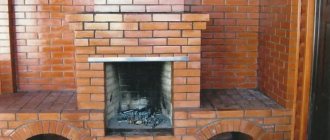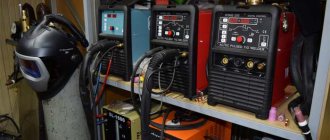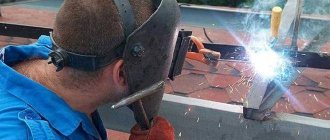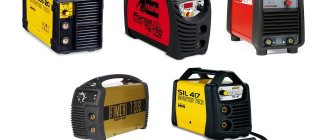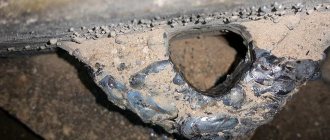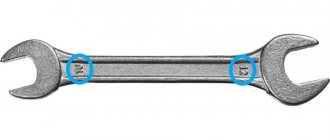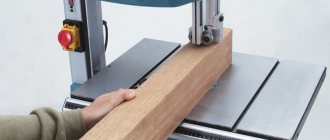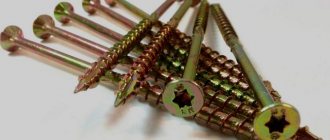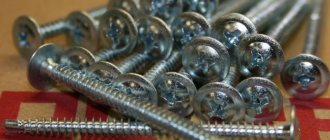The electrode holder is included with the welding machine. Its function is to hold the electrode in the desired position during the welding process and provide current supply to the work area. The quality of the accessory will determine the reliability of the welded joint, the formation of defects, productivity and safety of work.
The designs were gradually improved, the appearance and the principle of fixation changed, but the convenience and reliability of fastening was always valued. Welders use both old and new clamp models. They can be selected at your discretion and used with any welding machine. In addition, they periodically fail because they come into contact with a melting rod. The welding holder is easy to replace and rearrange due to its versatility.
Types of welding holders
The following designs can be used for welding machines.
Pin
An electrode holder of this design (spring or lever) is the most common and simple product.
The price of the clothespin holder is the lowest in comparison with parts of other designs. The use of this type of holding device allows you to quickly and safely perform welding work, while the quality of the weld will always be at a high level.
Fork trident
A simple device that makes it easy to fix an electrode of any diameter.
Great care should be taken when using a trident due to the large uninsulated area of the product.
The main advantage of a holder of this design is the possibility of self-production.
Collet
It is used exclusively when welding metal in a protective gas environment.
The device has a long service life and, when used correctly, allows you to perform work of the highest quality.
Non-burning holder
This type of device allows you to perform work using almost 100% of the length of the welding electrode. The flameless holder consists of a cylindrical handle (2), into which a metal pin (1) is mounted on one side.
The electrode is fixed by welding its end part to the contact pin.
Screw
Screw-type electrical holders secure consumables well, have good contact and uninterrupted power supply.
The contact surfaces have an anti-corrosion coating. With proper use, the device will last for many years.
How to choose the right electric holder
When selecting a holder, you should pay attention to the following characteristics:
- Size and weight of the device. The weight and dimensions of the holder are very important. When working for many hours, the extra 50 grams of the device will be felt. In this case, it is better to purchase a compact and lightweight design. If you have a choice, give preference to light and small parts, provided they have the same characteristics.
- Specifications. The holder must match the current strength. Failure to comply with this requirement will result in burnout of the contact part. If the contacts burn, further use of the device will be impossible. You can determine whether a device belongs to a category based on current strength by the markings that are applied to the non-replaceable part of the product.
- Quality of insulating material. To ensure safe performance of work, you should select a holder with a high-quality insulated handle. Plastic of sufficient thickness is used as a dielectric in almost all parts to reliably protect the welding machine operator from the effects of electric current.
- Price. You can buy a holder for a welding machine from 100 rubles, but the quality of a cheap model will not differ. Branded copies sell for several hundred dollars, but for everyday work there is no need to purchase holders at that price. It is enough to purchase a product in the middle price category to provide yourself with a high-quality tool for welding metals for a long time.
An inexpensive device can be purchased as a spare part. If the main device fails, if you have an additional holder, you can continue working without a serious time delay.
The best holder models
To purchase an electrode holder for a welding machine and not be disappointed in its quality, you should choose models that have been used by welders for a long time and do not cause negative emotions in them.
Negative reviews most often occur about Chinese-made products, but low-quality products can enter the domestic market from other countries.
In order not to make a mistake when choosing a holder, it is recommended to purchase the following models:
1. ESAB Handy 200 (200 A) - is in great demand among professional welders.
The part has high performance characteristics that do not decrease throughout the entire period recommended by the manufacturer. The product was made in Sweden, so you can count on European quality.
The Handy 200 weighs 550 grams, but given the good insulating coating and high-quality clamp, the slight increase in the weight of the holder compared to other models is quite justified. Handy 200 is a screw holder, which allows you to perform welding work efficiently and safely.
When using the device, you can weld metal with electrodes with a diameter of 2.0 to 4.0 mm. The cost of the product on the Russian market is about 500 rubles.
2. Sibrteh 500A - an inexpensive but high-quality domestically produced instrument that can be used up to 500 A.
The Sibrtech 91455 500A holder is a clamp-type device in which the working electrode can be replaced quickly.
The product has reliable plastic insulation, which can protect the operator from the effects of electric current. You can buy it for 300 rubles.
3. ESAB 500 is a holder from a well-known Swedish company that has been producing high-quality products for more than 100 years. The esab electrode holder can be used for welding work with currents up to 500 A.
The main advantage of ESAB 500 products is their ultra-light weight, which is only 200 grams. The cost of the product on the Russian market is about 3,000 rubles.
4. Germany type 300 A - ideal for welding with currents up to 300 A and electrode diameter 2 - 4 mm. Thanks to the special corrugated design of the device’s handle, it is possible to achieve a reliable hold in the hand. The model is distinguished by high-quality plastic insulation and relatively low weight.
Read also: Brick cutting disc for grinder
The current-carrying part has a low resistance coefficient and high corrosion resistance due to the use of brass as the main material. The electrode can be fixed in the device in four positions, which makes performing complex work more comfortable and precise. You can purchase Germany 300 A for only 300 rubles.
It’s hard to say which electrode holders are most widespread among professional welders! It is safe to say that any of the samples described above can be used when performing complex welding work.
For a professional welder, and even for an amateur, a good electrode holder is the key to comfortable and convenient welding. When purchasing a holder, you need to know how to choose a much-needed item for welding work, what points you need to pay special attention to, so that later problems do not arise when using it.
Peculiarities
The holder of the welding unit is a device that controls the electrode during welding work.
It must conscientiously hold an electrode of any cross-section and supply electric current to it, providing controlled control of the process without additional effort. The variety of designs also determines the variation in the technical and operational characteristics of the holders, however, there are also final values approved by GOST. For example, the length of the protected part of the handle must be at least 110 millimeters, and the average cross-section is in the range of 36-40 millimeters. The size of the clamp also affects the ability to work with electrodes designed for different levels of electrical current.
The initial level is 200-300 A; holders with a diameter of 36 millimeters function with similar parameters, and samples for 400-500 A, therefore, must have a cross-section of approximately 40 millimeters.
The materials used to make the device must also be taken into account. They also determine the ability to work with different limits of electric current strength, and resistance to adverse environmental conditions.
The combination of scale-resistant steel and high-strength plastic with corrugations on the surface will make it possible to protect the working base of the electrode holder from both high temperatures and cold if work takes place outdoors in winter.
Device
Let us briefly consider the design of the electrode holder. Several important factors depend on the design of the device:
- quality of welded joints;
- master's labor productivity;
- convenience and safety of work.
inexpensive electrode holder
A standard type holder is a tool consisting of several parts: body, clamp, handle, moving parts. But different species may have some structural features . More details below.
Let us briefly consider what types of electrode holders exist. Electrode holders are divided into universal and specialized . The production of both groups is regulated by GOST standards. For homemade ones, see the separate subheading below.
The universal electrode holder is the most popular, as it allows welding in various spatial positions.
There is also a more detailed classification:
1. Clamping clothespin holder (spring or lever) is characterized by a simple design and low price. The main disadvantage is weak fixation of the electrode.
This type can be made in two modifications:
- simple is compatible with most types of welding machines and the complete absence of non-insulated areas;
- automated ensures high seam quality, significant energy saving and automatic arc ignition.
2. Screw electrode holders allow the cathode to be firmly fixed. The main disadvantage is the need to constantly unscrew and tighten the screw in the clamping device when changing the material for welding.
We suggest watching a video where the user compares two holders, a screw one and a clothespin, and makes a choice in favor of the screw one.
3. The design of non-flammable is designed in this way: the electrode is not fixed with a clamp, but is welded to the end of a rod with an insulated surface and completely melts during the joining process. Then the next rod is taken.
4. Quite popular among welders of any level is the trident fork . However, this type, made in a simple modification, poses a serious threat to the health of the master due to the large number of unprotected parts.
Homemade fork holder
5. The collet holder is used in argon arc welding torches.
6. The electrode holder with a rotary type clamp allows you to quickly and reliably fix the rod at only one angle.
In addition to the above types, there are also special-purpose units that are used to create a certain type of seam.
Types of electrode holders
Electrode holders come in two types: universal, specialized; Sometimes a group of homemade holders is distinguished, although both of them can be made using a homemade method. The production of electrode holders and the requirements for them are regulated by state standards.
Universal holders are the most popular; they hold electrodes of different thicknesses equally well and allow parts to be connected in different spatial orientations. In most cases, the electrode is installed perpendicular to the clamp axis.
According to the method of holding the electrode, universal holders are:
- Clamping (clothespin, pliers) - spring, lever;
- Screw;
- Collet clamps;
- In the form of a fork (trident);
- Non-gargaric.
Holders with a clip in the form of a clothespin or a lever have a simple design and low cost. Their disadvantage is that the electrode is poorly fixed; This can be corrected by installing a stiffer spring. Clamping devices are produced in two modifications: simple and automated.
The simple model of the clamping device is compatible with most types of welding machines, and there are no uninsulated areas. Automated models automatically ignite the arc, are more economical, and allow you to obtain high-quality seams.
In a screw clamp, the electrode is inserted into the hole from the side and clamped with a screw from the end. This fastening method ensures high connection strength and good electrical contact. Statistics show that the share of screw electrode holders is close to 100%.
The collet holder is designed in the form of a tube. It has a thread at one end and a conical thickening at the other. The thickened part has three thin longitudinal slits. When the sector nut is rotated, the tubes bend towards the center and securely fix the electrode. Most often, the holder is used in torches for welding in argon.
The fork holder remains in demand among welding masters. Often it is made independently from scrap materials.
The popularity of the device is due to the extreme simplicity of the design, which has no moving parts, reliability, and durability. These advantages more than offset the unpresentable appearance and poor insulation.
In a flameless holder, the electrode is welded to the end surface of the insulated housing. When the electrode rod melts during the welding process, a new electrode is attached in its place in the same way.
A good electrode holder should:
The electrode holder must meet the following mandatory requirements:
- Reliability and confidence in fixing electrical conductors of any diameter in the required position.
- Possibility of quickly changing the electrode exit angle.
- Good and complete contact .
- Ensuring quick electrode replacement.
- Durability of use.
- Lightness of the device.
- Insulation of live parts.
- Possibility of welding in hard-to-reach places.
Requirements for electrode holders
The requirements for this welder's accessory are formulated as a result of generalizing long-term experience in joining metals. Ease of use, productivity, and quality of connections directly depend on compliance with the requirements.
The electrode holder must provide:
- Reliable fixation of welding rods of all diameters in any spatial orientation relative to the holder axis;
- Quick change of electrode mounting angle;
- Good electrical contact with a large contact area;
- Quick removal of underburned material, installation of a new rod;
- Long period of operation;
- Insulation of conductive parts of the structure;
Ability to create connections in places with limited access; the device should have a small mass: the lighter it is, the less tired the welder’s hand is.
How not to buy a low-quality holder for a welding machine
Live parts of a quality device must be made of copper and protected with insulating material. Some unscrupulous companies manufacture live parts from steel and then coat them with copper. Thus, the parts become very hot and burn quickly.
They look like copper and it is difficult for a non-professional to visually distinguish them from “all-copper” parts. There is one surefire way that requires a magnet. It is necessary to bring a magnet to the part being tested; if the parts are magnetic, then they are made of steel.
Copper jaws of the holder
Popular manufacturers
Let's move on to popular manufacturers of electrode holders.
Telwin is a world leader in welding machines, cutting systems and chargers. The Italian company offers holders under the same brand.
Spring electrode holders for welding work from the German company ABICOR BINZEL are distinguished by the following characteristics: high-strength and heat-insulating handle; rigid fixation of the dynode in four positions; ergonomics; strength; versatility of use.
Trafimet was founded in 1974 in the Italian city of Vincenza . The manufacturer offers spring-type tools with the following technical parameters: low weight of the unit; reliability; ease of use.
The Russian company produces inverter equipment. Holders from this manufacturer are manufactured in compliance with all state standards; allow welding in all positions, as well as in hard-to-reach places.
The Swedish concern
ESAB is one of the world leaders in the production of equipment, materials, accessories, protective equipment and other accessories for welding.
The wide range also includes screw-type electrode holders, characterized by maximum safety and quality of work. See the video above. EWM 's head office and production are located in Mündersbach, Germany. The company specializes in the manufacture and sale of a wide range of equipment, including electrode holders of various types.
The Russian brand BRIMA occupies one of the leading positions in the market of equipment, components and materials for welding. Electrode holders are designed for three groups of consumers: household, professional and industrial.
Read also: Electrical resistivity of constantan
SANTOOL a reliable manufacturer and supplier of quality welding products. The equipment is produced under several brands. The devices have a reliable fixation, electrically conductive parts are insulated from accidental contact.
The Russian company Skrab sells products under its own brand of the same name, and also supplies professional equipment from leading manufacturers. The equipment is used in many fields of activity.
SIBRTECH is a domestic manufacturer of high-quality tools and equipment. The company offers clamp-type electrode holders. When working with units, it is important that the electrically conducting parts do not come into contact with the product being welded or with human hands. regarding the products of this manufacturer , watch the video above and below .
The Italian company Quattro Elementi is engaged in the manufacture and sale of equipment, materials and accessories. Ergus brand .
Kord company is the largest Russian manufacturer of innovative equipment and accessories for welding. The clamps presented in the assortment are created in accordance with GOST standards and have different types of design.
In 2014, the Moscow company opened its own production of electrode holders and grounding terminals under the Saturn . The clamps are easy to use and are ideal for both domestic and professional level welding inverters.
Review of popular models
Among the wide variety of electrode holder models and brands, the following manufacturers and brands are the most popular among welders.
The electrode holder ED-40 “Kord” (Russia) works on the principle of pliers. It features the ability to install the electrode at several angles and adjust the spring pressure. Works with electrodes with a diameter of up to 6 mm in everyday life and in production.
The DE 2500 spring-type electrode holder from ABICOR BINZE (Germany) is ergonomic and reliable. Provides rigid fixation of the electrode in four positions. Cooks with current up to 500 A. Modern insulating materials of the handle can withstand heavy loads and reliably protect against electric current.
The Esab electrode holder from the leader in the welding equipment market ensures ideal current supply and strong electrode attachment.
Advantages of the device:
- ergonomic design and modern design;
- small dimensions without protruding parts;
- they are easy to work with;
- maximum contact of conductive parts;
- Thanks to the design of the handle, it can be used for a long time;
- works in all spatial positions;
- There are two holes for installing electrodes: at 45 and 90°;
- electrical safety.
The following models of Esab electrode holders are available on the market:
- Esab 200, 400 and 500;
- Optimus;
- Eco Handy;
- Eco Confort;
- Prima.
ESAB Handy 200 (200 A) - is in great demand among professional welders.
The part has high performance characteristics that do not decrease throughout the entire period recommended by the manufacturer. The product was made in Sweden, so you can count on European quality.
The Handy 200 weighs 550 grams, but given the good insulating coating and high-quality clamp, the slight increase in the weight of the holder compared to other models is quite justified. Handy 200 is a screw holder, which allows you to perform welding work efficiently and safely.
When using the device, you can weld metal with electrodes with a diameter of 2.0 to 4.0 mm. The cost of the product on the Russian market is about 500 rubles.
ESAB Eco Handy 300 electrode holders are designed for use with all types of welding current for surfacing and manual arc welding. Rated load current – 300 A.
A powerful threaded rod forms the basis of the clamp. It is made of brass for the best current transmission. Contact areas with anti-corrosion coating. The design and selection of materials prevent contacts from burning. The handle is made of high-strength insulating material for safety. To connect a welding cable with a cross-section of 50 mm², a screw connection is used.
The Esab Handy 300 electrode holder is characterized by convenient and reliable operation. Indispensable when welding in hard-to-reach places where spring fixation is unacceptable.
The clamp-type electrode holder Esab PRIMA 300 is a reliable installation of the electrode in any position, eliminating bending. The accessory is used for MMA mode. Rated current load is 300 A. The diameter of the consumables used is 2.5–6 mm.
The head of the holder has a cast, closed shape. The head and handle are completely insulated. To install and replace the rod, simply press the handle. Insert the bare end of the electrode into the hole and release the handle. There can be a left, right or straight position of the rod. To connect the cable, the handle is screwed together. A cord is passed through it and inserted into the holder. The position is fixed with a screw and a copper plate.
ESAB 500 is a holder from a well-known Swedish company that has been producing high-quality products for over 100 years. The esab electrode holder can be used for welding work with currents up to 500 A.
The main advantage of ESAB 500 products is their ultra-light weight, which is only 200 grams. The cost of the product on the Russian market is about 3,000 rubles.
Electrode holder SIBRTECH ED-500 A is designed for welding operations of all degrees of complexity. It is easy to use and holds the electrode firmly. The device is durable and reliable in operation.
Electrode holder SIBRTECH ED is a universal option for beginners and professionals.
The holder uses the principle of clothespins. Installation and replacement of the electrode occurs quickly, without additional effort. The body and handle are made of impact-resistant plastic with insulating properties.
The holder is designed for use with electrodes with a cross section of 2–6 mm. Maximum current – 500 A. Core of the connected welding cable – 50–70 mm².
Electrode holder “Cedar” type 200A is universal, durable and convenient. The holder rigidly fixes and holds the electrode in 4 positions. The insulating material of the oval handle can withstand high loads.
Rated welding current – 200 A.
In addition to universal devices, special electrode holders are produced. They allow you to cook with several rods or a three-phase arc at once.
Germany type 300 A - ideal for welding with currents up to 300 A and electrode diameter 2 - 4 mm. Thanks to the special corrugated design of the device’s handle, it is possible to achieve a reliable hold in the hand. The model is distinguished by high-quality plastic insulation and relatively low weight.
The current-carrying part has a low resistance coefficient and high corrosion resistance due to the use of brass as the main material. The electrode can be fixed in the device in four positions, which makes performing complex work more comfortable and precise. You can purchase Germany 300 A for only 300 rubles.
It’s hard to say which electrode holders are most widespread among professional welders! It is safe to say that any of the samples described above can be used when performing complex welding work.
PS If welding holders for manual arc welding are selected correctly, the connection of metal structures will be comfortable.
Sources
- https://stroy-podskazka.ru/svarka/svarochnyj-derzhak/
- https://WeldElec.com/svarka/post/osnastka/derzhatel/
- https://plavitmetall.ru/oborudovanie/derzhak-dlya-svarochnogo-apparata.html
- https://WikiMetall.ru/oborudovanie/elektrododerzhatel.html
Why buy a welding holder separately if it is already included with the welder?
Beginning welders often ask the question: “Why buy separately holders for a welding machine if the inverter is already equipped with a clamp?”
The standard holder from the inverter is broken
The answer to this question is quite simple: such an electrode holder is of low quality, and accordingly it will not work for long. In addition, unscrupulous manufacturers often use cheap materials to make components for the inverter. This has a positive effect on price and a negative impact on quality. Most often, the clamping jaws fail; they burn out and no longer provide fixation of the rod.
How to choose
Choosing a tool is a responsible task designed to make further work safe and efficient, and a welding electrode holder is no exception. Let's consider what should be taken into account when choosing what parameters.
1. Amperage. The electrode holder must match the current strength of the welding equipment used. So, when using a welding inverter with a current of 300A, connecting to it a holder that is not rated for 150A is not a very good idea. The electrode holder in this mode will last no more than two days, since the electrode clamp will burn and fail. In addition, using a holder with a lower amperage is simply not safe.
In the opposite situation, when holders are purchased “with a reserve”, that is, a 300A holder is installed on a 160A device, the solution is safe, but not very convenient for operation. With a higher amperage, the dimensions and weight of the holder are larger (which will affect the welder’s fatigue and the ability to get into hard-to-reach places, see the following requirement) , since the insulation is thicker, the cast parts, and the electrode clamp are more massive. Therefore, it is necessary to select a holder based on the strength of the welding current.
2. Dimensions and weight. For convenience, the device should have low weight and small dimensions. Extra grams will in no way affect short-term work, but during long-term processes that require attention and accuracy, a heavy unit can cause discomfort and muscle tension . Therefore, when choosing from several models with similar technical characteristics, you should give preference to the lighter and more compact one.
Dimensions and weight of welding holders - feel the difference
3. Work is often carried out under unfavorable conditions: dust, dirt, humidity, too high or low temperatures. Compensation for these factors should be the high reliability of the electrode holder. The body of the device is most often made of plastic with high insulating properties. When it comes to clamping, professionals prefer a molded one, since plate type jaws are more prone to failure. The most reliable option is a screw device; its threaded fixation guarantees an unambiguous position of the rod.
4. Well-known manufacturers maintain their reputation and carefully control the quality of their products. Therefore, proven brands are in high demand among consumers. Here it is worth adhering to the principle of sufficiency - an inexpensive holder from an unknown manufacturer will most likely not last even a month at a shipyard if it is operated in two shifts, but for an amateur welder it will last for two or three seasons, or even longer.
5. The next, most important one, cost, directly depends on the previous factor. The price varies widely. Cheap models, by definition, cannot be distinguished by a high level of quality and reliability, thoughtful design, and in rare cases they are designed for long-term operation. But an inexpensive tool is well suited for an amateur welder to perform one-time work. On the other hand, to carry out household welding there is no need to buy an expensive device, which is necessary for professional and industrial scales.
6. The greatest demand among customers is for units capable of fixing electrodes of any diameter . Since such devices are universal and can be used for a variety of work.
Purchasing a high-quality welding machine does not guarantee high quality welding work. To obtain a high-quality seam, you need a convenient electrode holder for the welding machine, with which you can effortlessly maintain the correct position of the electrode when welding.
What to look for when choosing
First of all, it should be taken into account that high-quality electrode holders for welding machines have current-carrying parts made of copper. For fakes, they are made of steel coated with a thin layer of copper, which quickly fades. In appearance they are indistinguishable from the originals, so a magnet will be needed to check.
The holder for welding is selected according to the following criteria, taking into account the characteristics of the work:
- Weight and dimensions. For periodic welding at home, these parameters are not critical. However, for long-term work it is better to choose a lightweight model, since holding extra grams for a long time will be tiring.
- Performance characteristics. The maximum current of the holder should be 10% greater than that of the welding machine. At a lower value, the points of contact with the electrode will quickly burn out. However, you should not get carried away with increasing the current reserve, since the dimensions and weight will increase, but the service life will not change.
- Reliability. For a welding holder for outdoor use, the handle material must be resistant to low temperatures and high humidity. Models with cast jaws will last longer than those with type-set jaws. Screw welding holders with a threaded clamp are considered the most reliable in terms of the method of fastening consumables.
- Method of connection with welding cable. The best option would be a bolted one. It is not worth spending money on holders made in China with a crimp connection method.
- Diameter of electrodes. When choosing, you need to pay attention to the diameter of the welding rods the holder you like is designed for. Otherwise, it may happen that the purchased model is designed to work with consumables from 5 mm, so it does not clamp the “four” or less.
- Price. Manufacturers offer welding holders at prices ranging from 100 to 10,000 rubles. At the same time, the design of cheap models does not differ from expensive ones. The difference in price is due to the quality of materials and workmanship. For a novice welder performing one-time work, an inexpensive model is quite sufficient. It is useful to have a cheap holder as a spare if the main one breaks during welding.
To extend the service life of the holder, the clamp is regularly cleaned of dirt and scale to prevent burning due to poor contact. Moving parts are lubricated, handled carefully, and stored in a clean place. Do not allow the electrodes to melt close to the clamp.
A high-quality and comfortable holder does not distract from the welding process.
Types of welding holders
Depending on the area of application, electrode holders can be divided into two large groups - universal and specialized. The use of specialized fasteners is regulated by the relevant GOSTs; their use in publicly accessible areas is quite limited. Universal holders are structurally divided into five groups:
- electrode holders – “clothespins”;
- electrode holders – “tridents” or “forks”;
- collet electrode holders;
- non-burning electrode holders;
- threaded electrode holders.
Read also: Wood stitching - what is it?
Holders – “clothespins”
The electrodes are secured in holders of this type using a spring or lever clamping mechanism. These models are made with a reliable heat-resistant dielectric coating, which guarantees the safety of the welder and eliminates unauthorized sparking. The contact surfaces have a toothed structure, which allows you to quickly and reliably secure the rod as needed for work.
The main advantages of holders of this type are simplicity of design, availability and low cost. With the help of such holders you can obtain high quality seams. Thanks to the correct positioning of the welding rod, rapid ignition of the arc is ensured. The disadvantages of clamps of this type include the low reliability of fixing the rod when the spring-loaded lever is loosened.
“Fork” holders
This welding machine holder is the most popular electrode holder model among professional welders. It is a structure consisting of three steel rods welded together, and the rods are welded so that the middle one acts as a spring, pressing the rod against the other two. Due to its simplicity, such a clamp has a low degree of protection, since a significant part of it is energized.
In addition to the presence of unprotected surfaces, the disadvantages of such clamps include the difficulty of removing the cinder, and in addition, they are not very convenient to use.
Collet type welding fixtures
Collet-type welding electrode holders are a rather complex design. The rod clamp in these devices is made on the same principle as the drill clamp in a hand drill. It is very difficult to make such a clamp yourself; this will require the use of professional equipment - lathe, milling, drilling machines. In addition, very high precision machining of parts is required.
Collet-type electrode holders are used in torches in the argon-arc process - welding in an argon inert gas environment.
Threaded or screw holders
The screw welding holder is the most popular among welders. Due to the fact that pressing is carried out by screwing the clamping head, reliable fixation of the rod in the device is ensured. Equipped with an ergonomic handle made of dense dielectric, a dielectric screw-down clamping head, this electrode holder does not have exposed live parts, which is a guarantee of safety for the welder.
These devices are available in several modifications:
- straight, with right-hand thread;
- straight with left-hand thread;
- curved with right-hand thread;
- curved with left-hand thread.
Specialized holders
Electrode holders of specialized models are designed to work in specific devices for the unique welding of certain products with special types of seams. One such device is a specialized welding unit that performs simultaneous welding with several rods. Specialized holders also work in machines for three-phase arc welding. All these models have a very complex design and are quite heavy for manual work.
Types of holders
Holders for manual arc welding are classified by design:
- Lever or spring type clothespins, due to their simple design and low price, have become the most popular option. To secure the electrode at the desired angle, simply spread the jaws by pressing the handle. Live parts are insulated. The size depends on the current value and the diameter of the consumables. Disadvantages include bulkiness and weak clamping of the electrode.
The electrode is attached between the jaws when pressing the handle
- The trident plug is no longer produced due to the lack of insulation on live parts. When welding, the welding rod burns out almost completely, but it is difficult to remove the cinder without a hammer or pliers. The fork's tines often burn out, so regular descaling is required to restore contact.
You can make a trident fork yourself
- Screw electrode holders firmly clamp the electrodes. Reliable contact is ensured by an anti-corrosion coating. The disadvantages include the relatively large amount of time required to rotate the clamp when changing consumables, and fastening only in a perpendicular position.
Screw-type electrical holder ensures reliable contact
- The collet is used primarily for joining small workpieces using argon arc welding at low currents. The holder is compact, easy to use, with easy replacement of consumables. The housing is reliably protected against electric current and temperature. Increased consumption of electrodes is noted, since short stubs cannot be left due to the risk of damaging the plastic insulation. The disadvantages also include current limitations.
Collet holder is used for argon arc welding
- The flameless holder consists of a metal rod on which an insulating handle is placed. A cable is connected to one end and an electrode is welded to the other. When it melts completely, grab the next one.
Non-flammable holder: 1. Metal rod to which the electrode is welded; 2. Handle; 3. Power supply
In addition to the listed types, specialized clamps are produced, for example, a holder for welding with three-phase current or multi-electrode. Such types are distinguished by their heavy weight and complex design, therefore they are used as part of mechanized complexes.
Basic technical data of electrode holders
When purchasing electrode holders, you should take into account what kind of work will be performed by the welding machine, what the power of the latter is, and what electrodes will be used during welding. Main technical characteristics that you should pay attention to when purchasing a holder:
- fastening type;
- fixation angle;
- electrode diameter;
- welding current;
- cable section;
- device weight.
The larger the cable cross-section, the higher the welding current, the larger the electrode diameter can be. But such holders also weigh more. For example, a screw-type clamp with a fixed angle “Superior 6” is designed for electrodes with a diameter of 4.0 mm to 6.3 mm, a cable with a cross-section of up to 70 mm 2 and a current of up to 400 amperes. The weight of the device is 690 grams.
The spring-type holder “Parva 2” is designed for installation of electrodes with a diameter from 2.0 mm to 3.2 mm at any angle; a cable with a cross-section of up to 25 mm 2 is connected to it, carrying a current of up to 200 amperes. The device weighs only 325 grams.
DIY welding holder
The design of some models of holders is so simple that many craftsmen prefer not to buy them, but to make these devices themselves. We are talking about fork-type holders. Such holders are considered classics in welding, and their production takes literally a matter of minutes.
To make such a holder, you will need one rod of corrugated fittings one meter long, a piece of thick rubber hose (as an option - a bicycle handlebar handle), an M10 bolt with two washers and nuts. The reinforcement rod is cut into three dimensional pieces, and one piece should be slightly longer than the other two. A bolt is welded to it, with the thread facing outward, and then the two remaining pieces, so that a trident is formed.
A rubber hose is pulled onto the structure from the bolt side. A washer is put on the bolt, the cable is connected, then a second washer is put on, secured with a nut and locked with a second nut. The teeth of the “fork” are cleaned with a file to ensure better contact with the electrode. The holder is ready for use. Its disadvantage will be poor protection of the welder from current-carrying parts, difficulty in removing the cinder, and oxidation of the reinforcement.
Some craftsmen use a steel angle instead of reinforcement, and as a pressing element they independently make a two-turn spring, which ensures reliable fixation of the rod. Small cuts can be made on the edges of the angle to install the electrodes at different angles.
Holder device
The design of a standard type electrode holder consists of several parts: body, handle, clamp, moving parts. There are differences in the design of some models. The holder body is a metal plate.
On one side, a hollow handle made of insulating material is attached to it, on the other, a movable part of the clamp.
- The surfaces of the clamping planes are corrugated and have grooves for selecting the spatial orientation of the electrode.
- A thick welding cable passes through the handle and is attached to the plate with a screw and nut. The design allows for almost instant replacement of the electrode by pressing the lever clamp.
- The spring is quite elastic and ensures reliable fixation of the rod in the selected position.
Holders of any type are not designed for long-term use; under the influence of high temperatures around the melting zone and high currents, they gradually lose their original qualities.
The insulating coating is destroyed, the contact between the copper cable and the steel case burns out, and the spring loses its elasticity. Old holders are periodically replaced with new ones.
